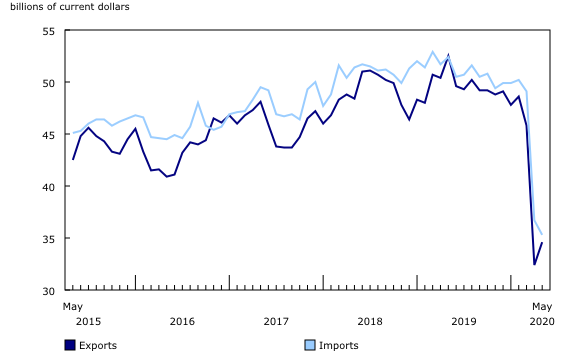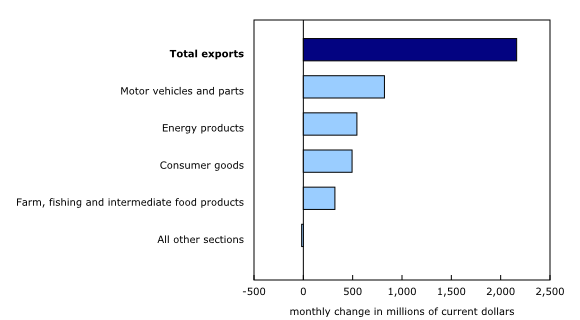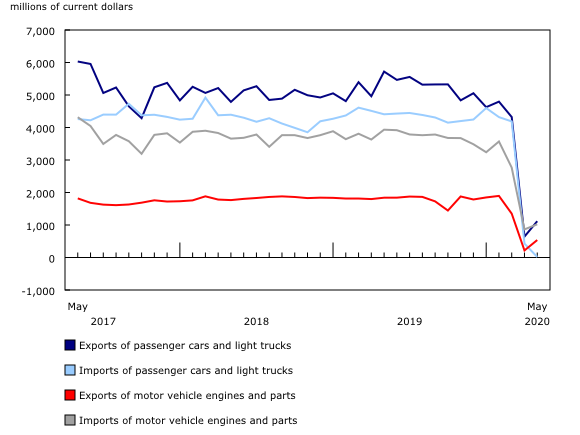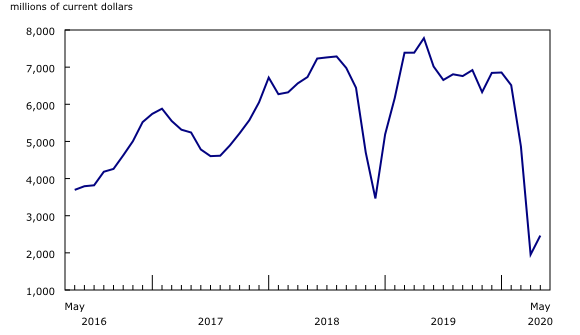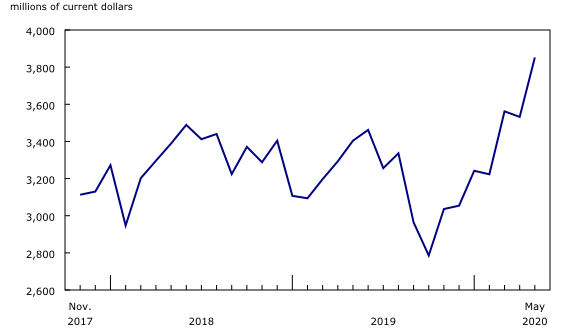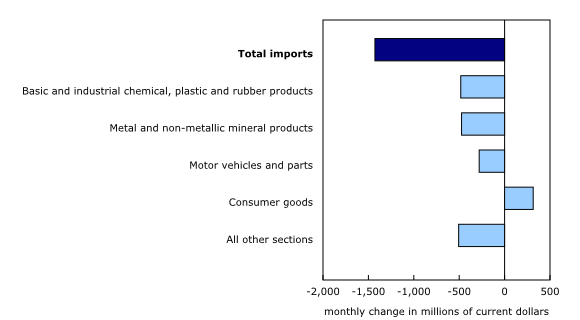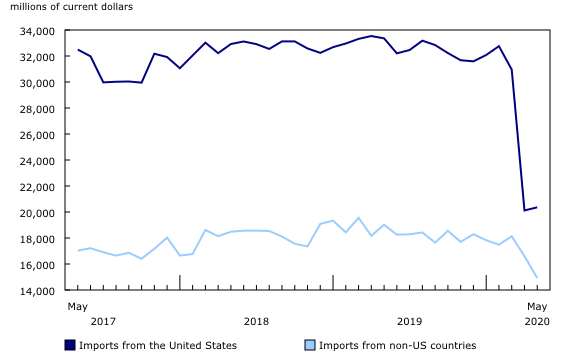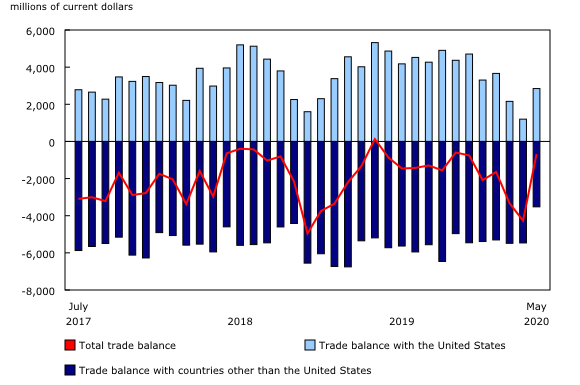Canadian international merchandise trade, May 2020
Archived Content
Information identified as archived is provided for reference, research or recordkeeping purposes. It is not subject to the Government of Canada Web Standards and has not been altered or updated since it was archived. Please "contact us" to request a format other than those available.
Released: 2020-07-02
Following historic declines in April that saw exports and imports lose more than one-quarter of their monthly value due to the COVID-19 pandemic, exports increased 6.7% in May, mainly reflecting the resumption of production in the auto industry as well as higher crude oil prices. Meanwhile, imports decreased a further 3.9%, reflecting supply challenges at a time when various economies around the world were progressively re-opening.
Canada's merchandise trade deficit with the world narrowed from $4.3 billion in April to $677 million in May.
In real (or volume) terms, exports were up 3.8% in May, while real imports fell 6.7%.
To explore the most recent results from Canada's international merchandise trade in an interactive format, visit the new "International merchandise trade monthly interactive dashboard." This new interactive dashboard is a comprehensive analytical tool that presents monthly changes in Canada's international merchandise trade data on a balance of payments basis, fully supporting the information presented every month in the Daily text.
Exports increase on higher shipments of motor vehicles and parts and higher crude oil prices
Following a 29.1% decline in April, total exports increased 6.7% in May, reaching $34.6 billion. Increases were observed in 8 of 11 product sections and non-energy exports were up 5.6%. However, on a year-over-year basis, total exports were down 34.1%.
Motor vehicles and parts was among the hardest hit product sections in April due to the pandemic, with exports falling $5.3 billion. In May, these exports began to ramp up, gaining $822 million. Despite this monthly increase, exports of motor vehicles and parts were down by almost 80% compared with May 2019. Both passenger cars and light trucks and engines and parts contributed to the monthly increase. By mid-May, some non-essential businesses in Canada, including automobile and automotive parts manufacturers, re-opened and gradually resumed production, which led to stronger exports.
After declining by almost half in April, exports of energy products rose 14.5% in May, mainly on higher exports of crude oil (+26.1%). Higher crude oil export prices were behind the increase in May, after falling sharply since January. Crude oil export volumes were also up in May. Despite these increases in prices and volumes, the monthly value for crude oil exports this month was still about one-third of what it was in January.
Following a 14.4% decrease in April, exports of consumer goods increased 9.5% in May. Exports of meat products (+26.0%) posted the largest increase. Certain meat processing plants in Canada were closed for a short period of time in April, and exports rebounded in May partly on higher demand in the United States, where more significant processing plant closures occurred.
Exports of farm, fishing and intermediate food products increased 9.1% to reach a record $3.9 billion in May. Despite the pandemic (and other factors like rail blockades and trade disputes), exports of this product section have been on the rise since the beginning of the year. This month's growth coincided with the recent increase of availability in the rail system in Canada due to a drop in demand for shipping other products during the pandemic. In May, exports of wheat (+19.5%) contributed the most to the overall increase. In addition, record levels were posted for exports of intermediate food products (+22.0%), as well as for fresh fruit, nuts and vegetables, and pulse crops (+12.5%), which rose for a seventh consecutive month.
Imports down again despite partial re-opening of the economy in May
After falling 25.2% in April, total imports declined a further 3.9% in May to $35.3 billion, with 7 of 11 product sections decreasing. On a year-over-year basis, total imports have lost almost one-third of their value.
Imports of basic and industrial chemical, plastic and rubber products (-14.4%) contributed the most to the decrease in May, mainly on lower imports of lubricants and other petroleum refinery products from the United States. This product category includes diluents used by the Canadian oil industry to dilute heavy crude oil. With lower exports of diluted crude oil to the United States in recent months, lower shipments of diluents came back to Canada in May.
Following a 77.0% decrease in April, imports of motor vehicles and parts (-14.8%) declined again in May. Imports of passenger cars (-96.5%) fell to almost zero, mainly on lower imports from non-US countries. This occurred despite many auto plants resuming production world-wide in May. When restarting production, foreign manufacturers are likely to prioritize domestic (or US) demand before exporting to other countries. Furthermore, overseas countries such as South Korea, Japan and Germany were the main contributors to this month's decrease. Shutdowns in those countries in April impacted Canadian imports in both April and May due to shipping time lags. Imports of engines and parts (+18.0%) meanwhile were back up in May, mainly on higher imports from the United States and Mexico.
Higher imports of consumer goods (+3.4%) partially offset the decline in total imports. Miscellaneous goods and supplies (+27.1%) and carpets, textile furnishings and other textile products (+42.5%) contributed the most to the increase. For both product groups, imports from China of various types of personal protective equipment—including facemasks and protective clothing—were behind the increase this month.
Lower imports from non-US countries, higher exports to the United States
Imports from non-US countries (-10.1%), which posted a less significant decline in April than imports from the United States, were responsible for the overall decrease in May. Although production shutdowns occurred in many of these countries in April, longer shipping times mean that the effects of important shifts may take longer to become apparent in Canadian import statistics. Imports from the United Kingdom (refined gold), South Korea (motor vehicles) and Japan (motor vehicles) contributed the most to the decline in May. Following significant declines earlier this year, imports from China (+6.2%) increased for a third consecutive month to reach $4.2 billion, the highest level since March 2019, mainly on higher imports of personal protective equipment.
Exports to countries other than the United States rose 2.4% in May, principally on higher exports to China (iron ore and crude oil) and France (aircraft and canola). Exports to China increased for a second consecutive month, and reached their highest level since December 2018. As a result, Canada's trade deficit with countries other than the United States narrowed from $5.5 billion in April to $3.5 billion in May, the smallest deficit since December 2016.
Exports to the United States were up 8.9% in May to $23.2 billion, which still represented a 40.0% decline compared with May 2019. Motor vehicles and parts and crude oil contributed the most to the rise in exports to the United States in May. Imports from the United States increased 1.2% to $20.4 billion, which represented a 39.0% year-over-year decrease.
As a result, Canada's trade surplus with the United States widened from $1.2 billion in April to $2.8 billion in May.
Revisions to April merchandise exports and imports
Imports in April, originally reported as $35.9 billion in the previous release, were revised to $36.7 billion in the current month's release, mainly on revisions to imports of gold products. Exports in April, originally reported as $32.7 billion in the previous release, were revised to $32.4 billion, with an upward revision to exports of gold products that partially offset significant downward revisions to crude oil exports.
Due to the unprecedented changes in trade activity resulting from the COVID-19 pandemic, atypical results may be observed within international merchandise trade statistics, and larger than usual revisions may be applied in future months. The same factors were also behind important revisions to imports and exports for earlier months in 2020.
Trade in medical and protective goods
The article "Trade in medical and protective goods, May 2020" was released today. This article describes trade in personal protective equipment with a particular focus on monthly variations in imports and exports in May 2020.
Monthly trade in services
Monthly exports of services were down 2.6% to $7.9 billion in May, while imports of services decreased 0.6% to settle at $7.8 billion.
Combining international trade in goods and services, exports increased 4.8% to $42.3 billion in May, while imports were down 3.3% to $43.1 billion. As a result, Canada's trade deficit with the world for goods and services combined totalled $562 million in May.
Note to readers
Merchandise trade is one component of Canada's international balance of payments (BOP), which also includes trade in services, investment income, current transfers, and capital and financial flows.
International trade data by commodity are available on both a BOP and a customs basis. International trade data by country are available on a customs basis for all countries and on a BOP basis for Canada's 27 principal trading partners (PTPs). The list of PTPs is based on their annual share of total merchandise trade—imports and exports—with Canada in 2012. BOP data are derived from customs data by making adjustments for factors such as valuation, coverage, timing and residency. These adjustments are made to conform to the concepts and definitions of the Canadian System of National Accounts.
For a conceptual analysis of BOP versus customs-based data, see "Balance of Payments trade in goods at Statistics Canada: Expanding geographic detail to 27 principal trading partners."
For more information on these and other macroeconomic concepts, see the Methodological Guide: Canadian System of Macroeconomic Accounts (13-607-X) and the User Guide: Canadian System of Macroeconomic Accounts (13-606-G).
Data in this release are on a BOP basis and are seasonally adjusted. Unless otherwise stated, values are expressed in nominal terms, or current dollars. References to prices are based on aggregate Paasche (current-weighted) price indexes (2012=100). Volumes, or constant dollars, are calculated using the Laspeyres formula (2012=100).
For information on seasonal adjustment, see Seasonally adjusted data – Frequently asked questions.
Revisions
In general, merchandise trade data are revised on an ongoing basis for each month of the current year. Current-year revisions are reflected in both the customs and BOP-based data.
The previous year's customs-based data are revised with the release of the January and February reference months, and thereafter on a quarterly basis. The previous two years of customs-based data are revised annually, and revisions are released in February with the December reference month.
The previous year's BOP-based data are revised with the release of data for the January, February, March and April reference months. To remain consistent with the Canadian System of Macroeconomic Accounts, revisions to BOP-based data for previous years are released annually in December with the October reference month.
Factors influencing revisions include the late receipt of import and export documentation, incorrect information on customs forms, replacement of estimates produced for the energy section with actual figures, changes in classification of merchandise based on more current information, and changes to seasonal adjustment factors.
For information on data revisions for crude oil and natural gas, see "Revisions to trade data for crude oil and natural gas."
Revised data are available in the appropriate tables.
Real-time data table
Real-time table 12-10-0120-01 will be updated on June 15.
Next release
Data on Canadian international merchandise trade for June will be released on August 5.
Products
The product International merchandise trade monthly interactive dashboard (71-607-X) is now available. This new interactive dashboard is a comprehensive analytical tool that presents monthly changes in Canada's international merchandise trade data on a balance of payments basis, fully supporting the information presented every month in the Daily text.
The product The International Trade Explorer (71-607-X) is available online and was updated with 2019 annual data revisions.
Customs-based data are now available in the Canadian International Merchandise Trade Database (65F0013X).
The updated Canada and the World Statistics Hub (13-609-X) is now available online. This product illustrates the nature and extent of Canada's economic and financial relationship with the world using interactive graphs and tables. This product provides easy access to information on trade, investment, employment and travel between Canada and a number of countries, including the United States, the United Kingdom, Mexico, China, Japan, Belgium, Italy, the Netherlands, and Spain.
Contact information
For more information, contact us (toll-free 1-800-263-1136; 514-283-8300; STATCAN.infostats-infostats.STATCAN@canada.ca).
To enquire about the concepts, methods or data quality of this release, contact Benoît Carrière (613-415-5305; benoit.carriere@canada.ca), International Accounts and Trade Division.
- Date modified:




